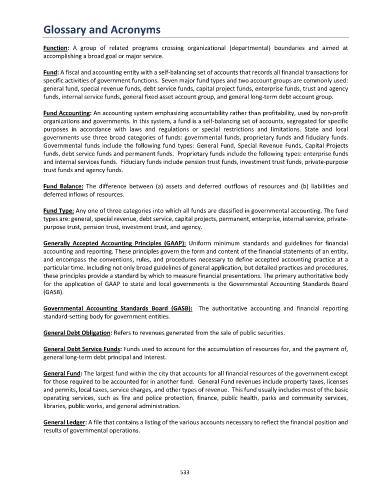Page 572 - Fort Worth City Budget 2019
P. 572
Glossary and Acronyms
Function: A group of related programs crossing organizational (departmental) boundaries and aimed at
accomplishing a broad goal or major service.
Fund: A fiscal and accounting entity with a self-balancing set of accounts that records all financial transactions for
specific activities of government functions. Seven major fund types and two account groups are commonly used:
general fund, special revenue funds, debt service funds, capital project funds, enterprise funds, trust and agency
funds, internal service funds, general fixed asset account group, and general long-term debt account group.
Fund Accounting: An accounting system emphasizing accountability rather than profitability, used by non-profit
organizations and governments. In this system, a fund is a self-balancing set of accounts, segregated for specific
purposes in accordance with laws and regulations or special restrictions and limitations. State and local
governments use three broad categories of funds: governmental funds, proprietary funds and fiduciary funds.
Governmental funds include the following fund types: General Fund, Special Revenue Funds, Capital Projects
funds, debt service funds and permanent funds. Proprietary funds include the following types: enterprise funds
and internal services funds. Fiduciary funds include pension trust funds, investment trust funds, private-purpose
trust funds and agency funds.
Fund Balance: The difference between (a) assets and deferred outflows of resources and (b) liabilities and
deferred inflows of resources.
Fund Type: Any one of three categories into which all funds are classified in governmental accounting. The fund
types are: general, special revenue, debt service, capital projects, permanent, enterprise, internal service, private-
purpose trust, pension trust, investment trust, and agency.
Generally Accepted Accounting Principles (GAAP): Uniform minimum standards and guidelines for financial
accounting and reporting. These principles govern the form and content of the financial statements of an entity,
and encompass the conventions, rules, and procedures necessary to define accepted accounting practice at a
particular time. Including not only broad guidelines of general application, but detailed practices and procedures,
these principles provide a standard by which to measure financial presentations. The primary authoritative body
for the application of GAAP to state and local governments is the Governmental Accounting Standards Board
(GASB).
Governmental Accounting Standards Board (GASB): The authoritative accounting and financial reporting
standard-setting body for government entities.
General Debt Obligation: Refers to revenues generated from the sale of public securities.
General Debt Service Funds: Funds used to account for the accumulation of resources for, and the payment of,
general long-term debt principal and interest.
General Fund: The largest fund within the city that accounts for all financial resources of the government except
for those required to be accounted for in another fund. General Fund revenues include property taxes, licenses
and permits, local taxes, service charges, and other types of revenue. This fund usually includes most of the basic
operating services, such as fire and police protection, finance, public health, parks and community services,
libraries, public works, and general administration.
General Ledger: A file that contains a listing of the various accounts necessary to reflect the financial position and
results of governmental operations.
533

